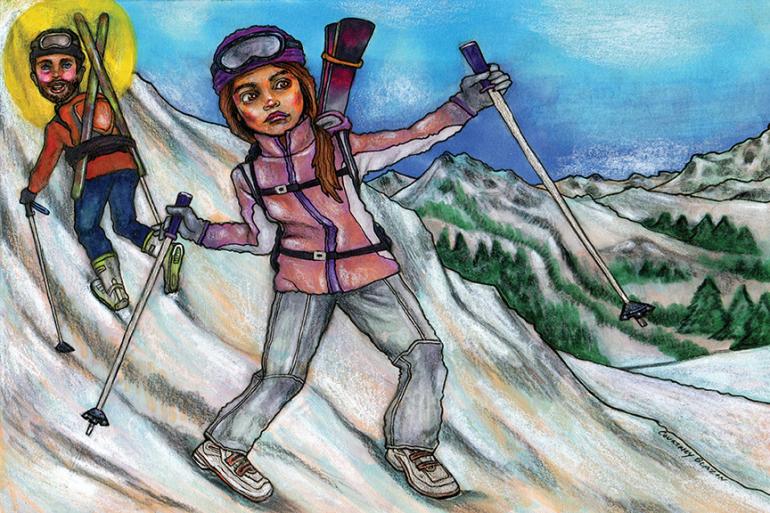Pushing Limits
Learning from a (way) better skier.
Let’s get one thing straight, if only to save my own ego: I’m no slouch of skier. My ski education took place at Missoula’s Snowbowl, widely known for its single green run, ongoing treasure hunt for a consistent fall line, and challenging melt-freeze southern exposure; and Montana’s backcountry, famous for white-knuckle lines in questionable conditions.
So I can hold my own—usually.
Last winter I started dating a guy who’s an exponentially better skier than me. I didn’t realize on our accidental first date, when we got stuck on the Snowbowl lift together and rappel-rescued by ski patrol, that he’s actually a local legend.
While I’m inclined to be impressed by this, our ability divide has also triggered issues about shared ski adventures, risk tolerance, and my own insecurities. In the beginning of our relationship, I let this dynamic play hell on my perception of myself as a good skier. Let me paint you a picture.
We went skiing in the Madison Range over Presidents’ Day weekend. On day one, we rolled out of our tent into the freezing dawn and shouldered our backpacks and skis for an attempt at one of the beautiful lines we’d been eyeing from our campsite. A few miles later found us at the base of the slope: steep and covered in frozen slide debris at the bottom, and steeper and exposed at the top. He was casual and confident as we strapped on our boots; I was more subdued as I assessed the conditions against my ability level.
We started the ascent using the frozen avalanche debris as a staircase until it dwindled, and then kicked steps into the icy face. As the trees became fewer and farther between, and the exposure more apparent, my fear of heights reared its ugly head and my heartbeat kicked into overdrive.
Usually I can control this fear, but coupled with the still-frozen snow (which makes for an iffy self-arrest without an ice ax), it sidelined me to the safety of a narrow talus strip. I watched him ascend away from me, confidently kicking steps into the face with his a-framed skis swaying on his back, to the top of a line that I couldn’t bring myself to conquer.
He did a set of acrobatics at the top to get his skis on, linked turns on bullet-proof steeps like it was a groomed run, and skidded to a stop next to me with a giant smile on his face. Cue feelings of inadequacy, made more intense by the relationship dynamic.
I sat with this for a few weeks until I decided that I could a) wallow in my lesser ability and allow it to prevent us from skiing together, or b) I could learn from it and become a stronger skier. Since pity parties are only fun for about 30 seconds, I went for option b on our next backcountry adventure.
Later that winter, we set out to ski another exposed line on Emigrant Peak. He was determined that I could do it based on my ability. I was determined to keep my fear under control and allow myself to be open to learning from a better skier—boyfriend or not.
I’m not going to lie: I sweated through that bootpack a lot more than the temperature warranted, thought about bowing out once or twice, and literally talked myself through the last 30 feet: “Trust your foot, step up, step on your foot.” He was patient, logically talking me through conditions and physics and technique.
This time, because I was open to learning from this dynamic, we stood next to each other on top of the line and skied its entirety together—he much more gracefully than I, but because I’d finally accepted that this wasn’t a competition, I could appreciate his grace.
Back at the car with cold beers in hand, we celebrated our shared adventure. And it was a hell of a lot more fun than a pity party.
Daring Dos
We can all push ourselves into situations above our skill grade. Here are some tips for avoiding that pitfall.
Be open to pushing yourself. This can be terrifying because it’s uncomfortable (physically and emotionally) but it’s also where the magic happens.
Know your limits and vocalize them. Pushing yourself is good, but going too far may mean endangering yourself as well as your partner if you shut down in a dangerous spot, injure yourself, or worse. Vocalize your ability level and where it might differ from your partner’s.
Try not to be hard on yourself. This might be the toughest advice to follow, but it might also be the most important for breaking through your own barriers. No one is absolutely fearless or accomplished at every single thing, and your partner doesn’t expect you to be either.
Choose the hero run once in a while. Not every ski adventure has to involve risk or type-2 fun. It’s okay to go for the low-angle, instant-gratification lines where you both feel like the best skiers ever. Because the bottom line is that we’re all out there for the joy of it, no matter our ability level—and maybe for the beer at the end.









